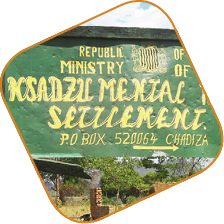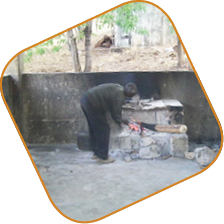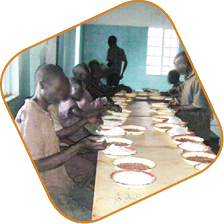8. Nsadzu Mental Health Settlement
In 2010, the Parliamentary Committee on Health and Social Development described Zambia’s three psychiatric “settlements” as “deplorable”. The Committee found that they “do not receive adequate funding to enable them to function efficiently and effectively.158 Monitors visited one of these centres – Nsadzu – in Chadiza District in the Eastern Province. Previously a lepers’ colony, the settlement is far from any urban area. The settlement’s purpose was to provide rehabilitation, family reunification and reintegration into the community for people with mental health issues abandoned by their families.
 Photo: Nsadzu Mental Health Settlement.
Photo: Nsadzu Mental Health Settlement.
26 October 2012. © MDAC
The Nsadzu centre was built in 1972. It had three houses for staff. Of the 19 patient blocks, 16 were hostels for residents. Each block had four rooms. Ten blocks were for men, six for women. Two enrolled mental health nurses worked at the centre, a security guard and general worker. A clinical officer of psychiatry was based 16 kilometres from the centre and occasionally reviewed residents.
Staff described the settlement as a dumping ground. A staff member working there for 15 years said, “I do not know if I will say [the settlement] is for rehabilitation or is for torment because I do not think the residents will ever go back.” She explained that, of the settlement’s 26 residents, she could only remember one patient receiving a visit by a relative, and only one resident having gone home.
Table 3: Capacity and occupancy of the Nsazdu Rehabilitation Centre. 159
|
Nsazdu Settlement |
Female section |
Male section |
|
Number of beds |
48 |
809 |
|
Number of residents on day of visit |
5 |
21 |
|
Average number of residents (reported by staff) |
5-7 |
17-19 |
|
Age range of patients |
25-50 |
20-65 |
|
Average length of stay (reported by staff) |
7 years |
10 years |
|
Longest length of current patient (reported by staff) |
15 years |
35 years |
 Photo: A resident roasts a rat in the kitchen of Nsadzu settlement, 26 October 2012. © MDAC.
Photo: A resident roasts a rat in the kitchen of Nsadzu settlement, 26 October 2012. © MDAC.
The settlement had no electricity, and the water supply was a hand pump bore-hole. The buildings generally looked maintained but furniture, bedding and kitchen utensils were grossly insufficient. There were benches and tables in the dining hall. The rooms observed had just mattress on the floor. A resident in a wheelchair told monitors that he could not use the toilets because they were not accessible. He had to use the bushes instead.
Some of the residents had been there since 1978. They could go on leave if approved by their relatives, but the staff said this had never happened. A young man living at the centre told monitors the following:
Under my circumstances I have no choice other than living here, but if I have a chance in a flash of a second I will leave this place.
My family members are initiators of my coming to the centre. I was in grade 11 and used to smoke marijuana. My brother in-law (husband of the elder sister) did not like me for that and an opportunity came when I became violent after smoking and I was admitted in Chainama hospital for two weeks. When I got home the house of our late father had been sold and the agreement we had with my sisters about sharing the proceeds was not kept. So, in the exchange of bad words, my brother in-law went and obtained a detention order for me and that’s how I found myself back in Chainama.
When I was pushed in to Chainama my brother in-law and sister convinced the hospital to find a place for me and when the hospital mentioned Nsadzu they said that was the best place for me. After the decision was reached with the hospital to send me to Nsadzu, I stayed at the F ward in Chainama for three months before being taken to Nsadzu.
Residents (particularly male) only interacted with the community in a limited way, by fetching wood, water and harvesting crops – for which they apparently got paid. A resident told monitors this was hard work for many residents who were elderly. Residents were prohibited from drinking alcohol and smoking ‘dagga’ (marijuana).
 Photo: Residents eating dinner at the Nsadzu settlement, 26 October 2012. © MDAC and MHUNZA.
Photo: Residents eating dinner at the Nsadzu settlement, 26 October 2012. © MDAC and MHUNZA.
All residents are on medication and seven of the eight residents monitors spoke to did not know the name of the drugs they were required to take. Staff accepted in principle that residents could decide about things such as food (the choices in this regard were not obvious to monitors) but for psychiatric medication staff were content to continue to override residents’ refusal to consent.
One of the female residents told monitors that she once had a relationship with a male resident who wanted to marry her. She became pregnant and was taken to the hospital where she was subjected to a forced abortion. Nurses told her to end her relationship. Staff confirmed this was the only pregnancy the settlement had ever had. The nurse in charge told monitors that, “residents must live like brothers and sisters since building relationship is not allowed in the centre”.
Residents complained about the food: cabbage and beans every day. The resident who used a wheelchair told monitors that he relied on other residents to bring him food because he could not physically access the place where the food was handed out. Sometimes residents forgot, and he was forced to stay hungry, he reported. Monitors saw a resident roasting a rat to eat before dinner. Another resident told monitors that he had been in the settlement for three months and in that time meat had only been served once.
The isolated and impoverished lives of residents at Nsadzu settlement are a serious concern. The conditions represent a serious breach of Zambia’s obligations under Article 19 of the CRPD, which sets out the right to live in the community for every person with a disability.
158 The three mental health ‘settlements’ were Nsadzu (Eastern Province), Litambya (Western Province) and Kawimbe (Northern Province).
159 There were 40 single male rooms and 24 single female rooms. Staff said that each room had capacity to accommodate two people if the number of residents increased

